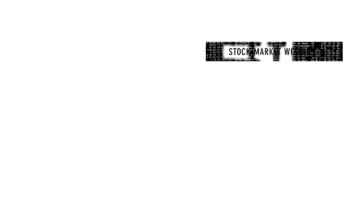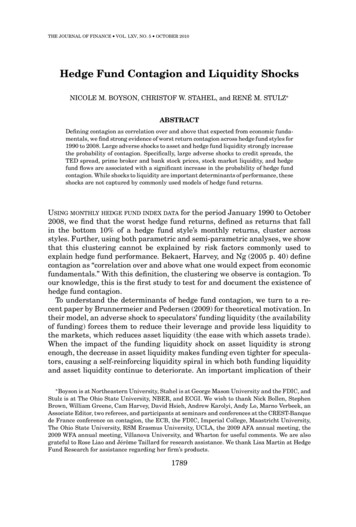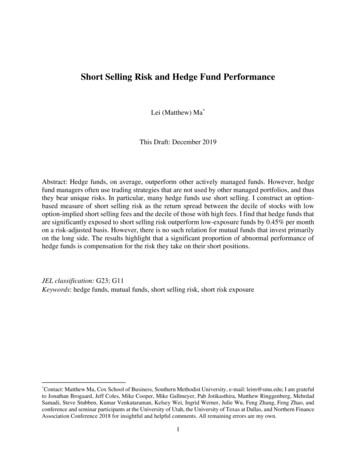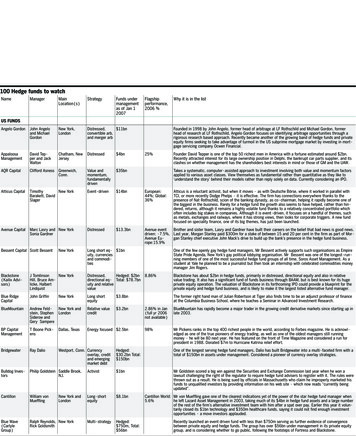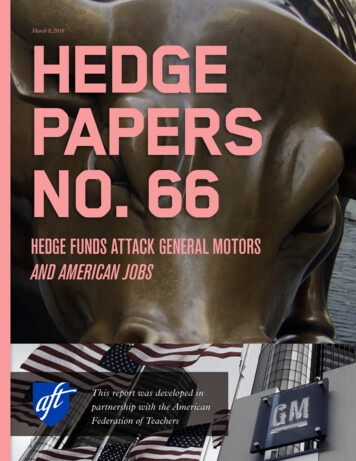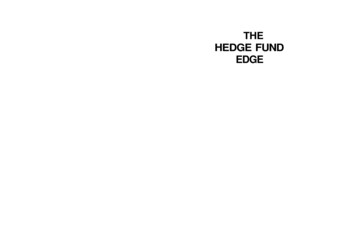
Transcription
THEHEDGE FUNDEDGE
Wiley Trading AdvantageTHEHEDGE FUNDEDGETrading without Fear / Richard W. Arms, Jr.Neural Network: Time Series Forecasting of Financial Markets I E. Michael AzoffOption Market Making / Alan J. BairdMoney Management Strategies for Futures Traders / Nauzer J. BalsaraGenetic Algorithms and Investment Strategies / Richard BauerSeasonality: Systems, Strategies, and Signals / Jake BernsteinThe Hedge Fund Edge / Mark BoucherManaged futures: An Investor's Guide / Beverly ChandlerBeyond Technical Analysis / Tushar ChandeThe New Technical Trader / Tushar Chande and Stanley S. KrollTrading on the Edge I Guido J. DeboeckTrading the Plan I Robert DeelThe New Science of Technical Analysis / Thomas R. DeMarkPoint and Figure Charting / Thomas J. DorseyTrading for a Living / Dr. Alexander ElderStudy Guide for Trading for a Living / Dr. Alexander ElderThe Day Trader's Manual / William F. EngThe Options Course: High Profit f Low Stress Trading Methods I George A. FontanillsThe Options Course Workbook I George A. FontanillsTrading 101 / Sunny J. HarrisTrading 102 I Sunny J. HarrisAnalyzing and Forecasting Futures Prices / Anthony F. HerbstTechnical Analysis of the Options Markets / Richard HextonPattern, Price & Time: Using Gann Theory in Trading Systems / James A. HyerczykProfits from Natural Resources: How to Make Big Money Investing in Metals, Food, andEnergy / Roland A. JansenNew Commodity Trading Systems & Methods / Perry KaufmanUnderstanding Options / Robert KolbThe Intuitive Trader / Robert KoppelMcMillan on Options I Lawrence G. McMillanTrading on Expectations I Brendan MoynihanIntermarket Technical Analysis I John J. MurphyForecasting Financial Markets, 3rd Edition / Mark J. Powers and Mark G. CastelinoNeural Networks in the Capital Markets I Paul RefenesCybernetic Trading Strategies / Murray A. Ruggiero, Jr.The Option Advisor: Wealth-Building Techniques Using Equity and Index Options /Bernie G. SchaefferGaming the Market / Ronald B. SheltonOption Strategies, 2nd Edition I Courtney SmithTrader Vie II: Principles of Professional Speculation I Victor SperandeoCampaign Trading / John SweeneyThe Trader's Tax Survival Guide, Revised / Ted TesserThe Mathematics of Money Management / Ralph VincePortfolio Management Formulas / Ralph VinceThe New Money Management: A Framework for Asset Allocation / Ralph VinceTrading Applications of Japanese Candlestick Charting I Gary Wagner and Brad MathenyTrading Chaos: Applying Expert Techniques to Maximize Your Profits / Bill WilliamsNew Trading Dimensions: How to Profit from Chaos in Stocks, Bonds, and Commodities /Bill WilliamsMAXIMUM PROFIT/MINIMUM RISKGLOBAL TREND TRADING STRATEGIESMark BoucherJOHN WILEY & SONS, INCNew YorkChichester Weinheim Brisbane Singapore Toronto
AcknowledgmentsThis book is printed on acid free paper. Copyright 1999 by Mark Boucher. All rights reserved.Published by John Wiley & Sons, Inc.Published simultaneously in Canada.No part of this publication may be reproduced, stored in a retrieval system or trans mitted in any form or by any means, electronic, mechanical, photocopying, record ing, scanning or otherwise, except as permitted under Section 107 or 108 of the 1976United States Copyright Act, without either the prior written permission of the Pub lisher, or authorization through payment of the appropriate per copy fee to the Copy right Clearance Center, 222 Rosewood Drive, Danvers, MA 01923, (978) 750 8400, fax(978) 750 4744. Requests to the Publisher for permission should be addressed to thePermissions Department, John Wiley & Sons, Inc., 605 Third Avenue, New York, NY10158 0012, (212) 850 6011, fax (212) 850 6008, E Mail: PERMREQ WILEY.COM.This publication is designed to provide accurate and authoritative information inregard to the subject matter covered. It is sold with the understanding that the pub lisher is not engaged in rendering professional services. If professional advice orother expert assistance is required, the services of a competent professional personshould be sought.Library of Congress Cataloging-in-Publication Data:Boucher, Mark, 1962 The hedge fund edge : maximum profit/minimum risk global trendtrading strategies / Mark Boucher.p.cm. — (Wiley trading advantage)Includes index.ISBN 0 471 18538 8 (alk. paper)1. Hedge funds.I. Title. II. Series.HG4530.B68 1998332.64'5—dc21Printed in the United States of America.10 9 8 7 6 5 4 3 2 198 18230Two broad groups of people deserve recognition and thanks forthe making of this book and for the events in my life that have ledup to it. The first people are what I term "the wind beneath mywings." These are the people who directly helped me in ways thatmade this book possible. The second group is what I term "theshoulders of greatness on which I stand." These are people whosework indirectly has been of enormous benefit and help to me notonly in putting this work together, but also in developing the con cepts described in many of the chapters.Among those who have been the wind beneath my wings, Iwant to thank my parents, particularly my mother, who through out my life has been willing to sacrifice anything to help me toachieve my dreams. I want to thank my significant other, AnitaEllis, without whose consistent help and support none of thiswould have been possible. I am grateful to my coworkers for alltheir hard work and effort. Thank you Larry Connors and othersfor proofreading and offering moral support. I also thank my firstpartners in the hedge fund business, Tony Pilaro and Paul Sutin,whose faith and support led me into this industry. And I want es pecially to thank Tom Johnson, my partner and friend, whose re search, faith, fascination, and support made this possible.This book is greatly enhanced by the previous efforts of oth ers who act as the shoulders of greatness on which this effort
viACKNOWLEDGMENTSstands. First and foremost, I must acknowledge with gratitudethe contribution of Mr. "X," a great European money manager.He asked to remain anonymous, but near the end of his life, heshared with me his knowledge and system for financial success.Mr. X, your work will indeed live on and not just with me.Next I thank Marty Zweig and Dan Sullivan for their work onavoiding negative periods in U.S. markets, which provided amodel of what to strive for, both internationally and across otherasset classes. Also, thanks Marty, for all those wonderful correla tion studies you filled your newsletter with each month fordecades—I saved them all and sought to apply my own reworkingof them to our master models.William O'Neil has done tremendous work on stock selectioncriteria, emphasizing ways to find the top performing stocks ineach market, and Frank Cappiello has done pioneering work onthe importance of institutional discovery in the odyssey of astock's rise from obscurity to prominence. Meanwhile, NelsonFreeburg has applied a never ending, incredible stream of timingsystems to a whole host of asset classes providing me with manyinsights. Also, I am tremendously indebted to all the people atBank Credit Analyst for their rigorous work and insight into theliquidity cycle across most tradable markets on the globe.My heartfelt thanks go to Ludwig von Mises, Ayn Rand, andMurry Rothbard for their selfless preservation of Austrian eco nomics, the ideals of capitalism, and truth. I am grateful for thework of Paul Pilser for putting economic myth in its place andbringing forth the theory of alchemy. I want to acknowledgeStanley Kroll for his work on money management and JaySchabacker for his brilliant melding of the liquidity cycle andmutual fund selection.Finally, I thank Tony Robbins for reteaching me how tochange and grow and for exposing me to some of the ideas onwhich this work is based. If there is anyone out there who has notyet drunk of the knowledge of any of the great innovators I haveacknowledged here, let me encourage you to partake immediatelyfor your own enrichment.M.B.ContentsIntroductionThe Importance of RiskHow It All StartedHow to Recognize a Market MasterUnderstanding Is Key to SuccessOverview of the Approach in This Book1 The Risk of Traditional Investment ApproachesThe Effects of a Long Term Bull MarketLong Term Returns in EquitiesProtection against Bear MarketsBlue Chip StocksInvestment CriteriaHigh Returns and High Consistency—The TradeoffSummary2 Liquidity—The Pump That Artificially PrimesInvestment FlowsUnderstanding the Austrian Interpretation ofthe Liquidity CycleThe Liquidity Cycle Illustrated with anIsland Economy1256991616192628303541434548
viiiCONTENTSThe Liquidity Cycle in Modern EconomiesTiming the Liquidity CycleUnderstanding Economic GaugesImplications for U.S. MarketsSummaryCONTENTS5162891001063 Index Valuation Gauges—Do Not Ignore thePrice You Pay111Using Index Valuation GaugesLimitations of Index Valuation AnalysisUsing Gauges for Mutual FundsValuation Gauges for International MarketsSummary1111151161171224 Macro Technical Tools—Making Sure the TideIs Moving in the Right DirectionThe Argument for Technical AnalysisTaking a Wider ViewUsing Technical Analysis to Confirm TrendsReading the Message of the MarketsOverview of Technical AnalysisAnswering Criticism of Technical ToolsSummary1241251281301321341461505 Containing Risk—Sound Strategy and MoneyManagement Methods and the Principles ofCharacter Necessary to Achieve ThemMoney Management RulesPrinciples of Character1511521616 The Essence of Consistent Profits—Understanding166Austrian AlchemyAlchemy versus EconomicsThe Long Run Growth ParadigmNegative Tax Policies168174180190ixDisastrous Social ProgramsMinimum Wage PoliciesEconomic Freedom IndexWhen Investing, Look for Countries withLow Impediments to GrowthProfiting from Understanding DistortionsSome U.S. DistortionsEvaluating Government/Media HypeSecular Themes and TrendsExamples of Secular Themes and TrendsSummary2062072092202272302397 Equity Selection Criteria Long and Short—How Profits Are MagnifiedMutual Funds.Individual Stock SelectionIdentifying Meteors and Fixed StarsEquity FuelMeasuring Price against GrowthModern Portfolio Theory MethodsStock Trading MethodSummary240241245248261265270. 2732858 Other Asset Classes and Models to Exploit ThemOutperformance and Asset AllocationBuilding a PortfolioExploring Asset ClassesSummary1982022042872872932943279 Asset Allocation Models and Global Relative StrengthAnalysis—Constructing a PortfolioUsing Asset Allocation ModelsGlobal Relative Strength: Radar Screen forFlexible Asset AllocationSummary329329336343
xCONTENTSAppendix A: Strategies for Short-Term TradersTrading Runaway MovesAppendix B: Recommended Books, Services,Data Sources, and LettersLetters and Services345347Data Services and SoftwareBooksFree Report355355358359360Appendix C: Master Spreadsheet ofSystems Performance362Index365IntroductionThis book is written for every investor or trader—large or small—who wants a methodology to consistently profit from the marketswithout incurring huge risks.In this era of exploding U.S. and global stock markets, manyinvestors are focusing most of their attention on returns, not onrisk. I can safely say that the methodologies advocated in thisbook offer highly pleasing potential returns. Our newsletter toclients has shown average annual returns of over 32 percent peryear since 1992, without a losing year and, more significantly,without a drawdown of over 10 percent (this has more than dou bled the total return of the Standard & Poor's 500 [S&P] overthis period). During this same period, the funds I have con sulted for have done even better in terms of both risk and re turn, with real money, investing millions of dollars globally.And in researching the concepts on which these methodologiesare based, my colleagues and I have gone back to the early 1900sto verify their rigor. Thus while I am confident that the method ologies described here can enable you to pull consistently largeprofits from the markets, I also hope that the book sharpensyour focus on two equally important factors of investment—riskand market understanding.
2INTRODUCTIONTHE IMPORTANCE OF RISKRecounting a personal experience may be the most effective wayto explain why risk should be of paramount importance to in vestors. In the early 1970s, when I was just nine years old, my fa ther died of cancer. He had struggled to try and leave me a trustfund with enough money to finance my future college education.Since I had at least a decade to go until reaching college age whenmy father set up the trust, he put it into stock funds managed by abank. From the end of World War II to the late 1960s, stocks hadbeen in a wonderfully profitable bull market. The public was par ticipating in stocks to the highest degree since 1929, and the pre vailing wisdom was that if one just hung onto stocks over the longrun, they showed a better return than nearly any other type ofasset. (This type of environment should sound quite familiar toinvestors of the late 1990s.)Things did not go according to plan beginning in 1972. From1972 to 1975, the value of that trust fund declined by over 70 per cent along with the decline in U.S. and global stock prices of acommensurate amount (the S&P and Dow dropped by around50% during this period, but the broader market dropped by muchmore than that). By the time I started college in the early 1980s,even the blue chip indexes had lost more than 70 percent of theirvalue from 1972 in after inflation terms. While my trust had re covered somewhat from 1975 to the early 1980s, it was nowherenear the level it had been before my father died. In the early1970s/ he believed he had provided enough funds for me to go toan Ivy League school—but a decade later the diminished trust ledme to opt for U.C. Berkeley instead. In no way could the trusthave covered the cost of an elite private school.The historical fact is that it would have been difficult to pick aworse investment class than stocks from 1972 to 1982. Even ex perts like John Templeton and Warren Buffett did poorly. This ex perience left me with a keen desire to understand what led tosuch a huge disparity in the returns of equities over such a longperiod. It also provided an extremely valuable lesson regardingrisk, which I sadly had to learn again with my own money beforeit really sank in.I began investing my savings from summer jobs and suchwhen I was a sophomore in high school. My first real killing cameTHE IMPORTANCE OF RISK3during the 1979 runup in gold prices. I had read several booksconvincing me that gold could do nothing but explode in price,and I plunged my entire savings into options on gold stocks. Theoptions took off, and my account surged by nearly 500 percentfrom March 1979 to January 1980. Pure luck helped, as I wasforced to exit my December 1979 options just before the gold mar ket peaked and crashed beginning in January 1980.I had caught the speculative bug. By early 1980, I was regu larly speculating in a host of highly leveraged commodity posi tions. Not knowing what I was doing, I lost small amounts ofmoney consistently until 1981, when I got caught short March '81Orange Juice during a freeze in early 1981. I was short OrangeJuice, which shot up from around 80 to 130 in a series of limit upmoves that lasted for more than a week and prevented anyoneshort from being able to get out of positions. By the time I couldcover my shorts, I had lost nearly half of my account and morethan half of the profits I had gained from gold's runup. My realeducation had begun, and I realized that I needed to study thesubject much more thoroughly to profit consistently from themarkets. The easy money I had first thought was for the takinghad really been luck. Having seen two accounts lose more thanhalf their value, I now realized the importance of limiting risk.The mathematics of losses and risk is sometimes lost on in vestors until they actually experience it up close and personally.When your account drops 70 percent in value, that means youwon't get back to breakeven until you have made over 230 percenton your remaining money. It hardly seems fair! One would thinkthat if you dropped 70 percent, you ought to be able to get back toeven when you made 70 percent—but that is not the way it works.As I started to voraciously study the works of investors who hadmade significant long run gains, I noticed that most great in vestors and traders sought to keep drawdowns (their largest lossfrom an equity high) around 20 to 30 percent or less—and mostmeasured their gains in terms of the drawdowns they had to sus tain to generate those gains. An investor who loses more than 20percent must show gains of 30 percent or higher just to get back toeven—and that could take more than a year to produce, even foran excellent investor.As the concept of weighing risk against reward hit home, in vestment performance suddenly meant more to me than making
4HOW IT ALL STARTEDINTRODUCTIONbig gains: it meant measuring those gains against the risk I wastaking to achieve them.If I can prevent just one person out there from going throughthe same painful experience I had from 1972 to 1982, then writingthis book has been a worthwhile effort. I hope I will convince morethan one of you. Similarly, if I can get one or more investors andtraders to think of performance not just in terms of total returnsover the short run, but in terms of reward compared with draw down and consistency over the long run, I will be pleased. Far toomany fund rating services only list performance in terms of re turn, while totally ignoring risk. Investors wanting to consistentlyperform well in the markets have to be much smarter than that.The goal of this book is to present a methodology for achieving marketbeating long-run returns with substantially lower risk than the long-runrisk of U.S. and global equities. However, just as important as givingthe reader such a methodology is to do it with honesty and in tegrity, based on the philosophy I have identified as essential forachieving low risk consistent market gains. To do this, I must ex plode some myths and misconceptions. And perhaps the most im portant lesson I have for market participants is that the answer totheir quest for superior performance doesn't lie in a Holy Grailsystem, but in their own development of the skills necessary tounderstand major market movements.While I provide dozens of specific systems and rules alongwith their historical records of market beating risk/reward perfor mance, I also stress that it is far more important to understandwhat lies behind their success and to keep abreast of anything thatcould change those underlying principles than it is to follow thoseexact rules and systems. This distinction is, in fact, the differencebetween market novices and market masters over the long term.The market novice constantly searches for "magic" systems thatwill deliver a fortune. The master tries to develop the necessaryskills and insight into markets and economics to consistently seewhat methodologies will work in the forthcoming environment.As I discuss in Chapter 6, the novice tries to find fish holeswhere the fish are biting today, while the master learns how to findthe fish holes where the fish are biting every day. The book is de signed to provide the skills that can convert novice investor/traders into potential market masters.5HOW IT ALL STARTEDAfter graduating from the University of California Berkeley inthe mid 1980s, I first traded on my own for a bit. While at a con ference on trading where I was a speaker, I met two key individu als: Tom Johnson, a Stanford Ph.D., and Paul Sutin, his student atthe time. They liked some ideas I had expressed on seasonal com modity straddles, and we decided to begin doing historical re search together, initially on ways to dispel the myth of theefficient market hypothesis, which had broad academic accep tance and basically held that achieving higher than average profitwith lower than average risk was impossible.Dr. Johnson and I began a research effort that lasted morethan three years and involved testing and developing nearlyevery theory we could get our hands on that had to do withachieving market beating performance. We tested every conceptwe could find going back to the early 1900s (or earlier, where dataexist; we found records for bonds and some stock indexes from aslong ago as the 1870s). We were striving to find something histor ically rigorous.Our research concentrated on two areas of study: (1) the test ing of market beating concepts and methods, and (2) the de tailed study of all those who had achieved market beatingperformance on a risk/reward basis historically and in the pre sent. Tom put significant resources into developing softwarethat could test and show intricate statistics for any simple orcomplex trading system or data set/concept for trading stocks,bonds, commodities, and currencies. As a result of building thishuge database and accompanying software, Tom and I alsostarted a small business selling the use of this software for test ing other people's ideas. Many large and small investors, traders,and institutions hired us to test their ideas or systems on ourlong term database. This research effort is the basis for the ideaspresented in this book, and I am grateful to Tom Johnson, PaulSutin, and the many others who helped put that research efforttogether. I also owe a huge debt of gratitude to the great marketmasters whose ideas we retested and found to be rigorous. Ihave no false pride about acknowledging ideas from others—my primary concern is with what actually works. Appendix B
6INTRODUCTIONprovides a list of the great investors and researchers whose workI have found to be exceptional; I urge you to read as many oftheir works as you can.HOW TO RECOGNIZE A MARKET MASTERA real life example will illustrate the difference between a marketmaster who strives for understanding and a market novice whosearches for magical systems. By some strange coincidence, Tomand I handled two projects within the span of a year or so that de pended on the same basic concept. Both of these investors had at tended a seminar by Larry Williams, in which Larry proposed asystem based on the discount/premium disparity between theS&P cash and nearby futures. Simplifying a bit, the concept wasthat one should buy the S&P futures any time that the futureswere closing at a discount to the cash S&P, and hold to the follow ing profitable close. Larry didn't use any stop loss in the versionof the system we were given by our first customer.The first customer—a market novice—had attended Larry'sseminar and began to trade this particular system (Larry usuallypacks more systems into a seminar than just about anyone, so I'msure this was just one of many such systems at the seminar). Thecustomer, who was showing consistent profits through this trad ing, was shocked at the success of the system and wanted a thirdparty to evaluate it before committing more capital to it. The yearwas late 1986.I backtested the system and found almost identical perfor mance to that illustrated by Larry Williams in his seminar. Theproblem was that S&P futures only began to trade in 1982, so therewasn't a timeframe long enough to evaluate the system properly. Imet with the client and explained two serious reservations that Ihad about the system. The first was the lack of stop loss protec tion—any system that does not limit losses is an accident waitingto happen according to my research. The second problem had to dowith understanding futures markets in general. Again simplifyinggreatly, most nearby contract futures markets trade at a premiumto underlying cash during a bull market, but trade at a discount tothe underlying cash market during a bear market. Theoretically,the futures should trade at a premium to cash equal to the T billTO RECOGNIZE A MARKET MASTERrate for the period between entry and futures delivery, but in re ality the premium/discount of nearby futures reflects whetherthere is a short term shortage or overly large inventory of product(or a reason for investors to panic buy or panic sell the underly ing instrument immediately). Since other financial instrumentssuch as currencies had shown a tendency to trade at a premiummost of the time, but at a discount during severe bear markets, Ireasoned that the S&P would be similar. This meant that the sys tem would likely fail in a severe bear period. I tried to convincethe client to add stop losses and some sort of filter to protect himagainst a bear market period if he wanted to continue to trade thesystem on its own.I described two types of stop loss and trend filters the clientmight use; these filters, however, would have cut total profits from1982 to 1986. I was surprised by the client's response. He saidsomething like, "You mean, it really does work!?" He took off fromour meeting very excited about the original system, and I had thestrange feeling that he hadn't heard a thing I said about stop lossesand trend filters.This client called back every few months to gloat that he wasstill making money with the original system and had been able toadd to his exposure to it. And in fact, for so simple a system, it hadworked remarkably well, generating thousands of dollars a yearper contract since 1982. It was very rare that one needed an extra 5,000 beyond normal initial margin to maintain each per contractposition, since it was usually only held until the first profitableclose, and so the client had increased his trading size every time hehad extra margin plus 5,000. He had made around 10,000 percontract, by his reckoning, up until October 1987. On October 27,1987, the day of the great market crash, the S&P December futuresclosed at a discount to the cash S&P, and this novice trader had du tifully bought as many contracts as he could on the close ataround the 874.00 level. The next morning, the December S&Popened at 859.00 and proceeded to plummet to the 844.00 levelvery quickly thereafter (the S&P contract was 500 per 1.00 pointat that time). This meant that on the open, the novice trader faceda potential margin call, because he had a 7,500 per contract lossand had only allowed 5,000 room. The trader exited as quickly ashe could to avoid potential ruin. He sold out very near the lows ataround 846.00 average fill for a one day loss of just over 14,000
8INTRODUCTIONper contract, which basically wiped him out completely. Had heused the trend filter and stop loss I had recommended, he wouldhave made far less profit until October 27,1987, but he would havestill made money through the crash. It is also worth noting that ifhe had had hugely deep pockets and courage of steel, he could havesurvived the day—the system actually did work, it just required aton of margin, but this trader was going for maximum profits.A few months later, we were reviewing the trading of an excel lent investor for input on how he could improve his already stellarperformance. Among the concepts he listed as exploiting was thesame Larry Williams concept of looking for buy signals near theclose of a day or on the day following one in which the nearbyS&P futures closed at a discount to cash. I inquired about the con cept and found that he had gone to the same seminar. However, Inoted in this trader's actual trades that he had done no buying onOctober 27, nor during future signals during the October No vember 1987 period.I asked this second trader why he had avoided these trades."Are you nuts?" he replied. "Sure I try to look for those opportuni ties, but only when I can do so with limited risk and use a stop loss. Besides, the risk of the market falling further was just toolarge—no one understanding what was going on at the time wouldhave even considered going long on the close. And in fact, I ignoredall of those signals until I was pretty sure we weren't in a consis tent downtrend, because in a consistent downtrend, closing at adiscount to cash might be normal."Now while the novice trader made several mistakes besides ig noring the basic rules of limiting risk and understanding what un derlies a system being used, what really differentiated him fromthe master trader was what he was looking for. The novice traderwas looking for a magical system that, when applied, would printcash for him. He didn't want to be bothered with potential short comings because he wanted so badly to find his pot of gold in asystem. Conversely, the master trader was simply looking for ideasor systems that he could understand and utilize to help find low risk, high reward potential trading/investing opportunities. Hewouldn't have dreamed of trading a system he didn't understand,or investing without proper stop loss protection. He wasn't look ing for magic; he was searching for ideas, concepts, systems, andmethods that would help him add another arrow to his quiver ofOVERVIEW OF THE APPROACH IN THIS BOOK9potential situations where he would find low risk opportunitiesfor profit. One wanted to be camped out by a fishing hole someoneelse had found where the fish were biting and bait his hook as fastas possible. The other was simply looking for another way to finda fishing hole where fish might be biting for a while.UNDERSTANDING IS KEY TO SUCCESSThere are many books, courses, and software that purport to sellHoly Grail systems. They are mostly hype that is based on a per ception of the world that does not jibe with reality. One of the rea sons there are so many such books and services is that there are somany traders and investors hunting for such systems. The pot ofgold they are hunting for, however, isn't at the end of the rainbow.That pot is built, coin by coin, based on your skills as a trader/investor, and on your ability to consistently find reliable ways tolimit your risk while participating in opportunities that have muchmore reward than the risk you are taking. The pot of gold doesn'tlie in some system outside yourself; it lies in the set of skills anddegree o
Option Market Making / Alan J. Baird Money Management Strategies for Futures Traders / Nauzer J. Balsara Genetic Algorithms and Investment Strategies / Richard Bauer Seasonality: Systems, Strategies, and Signals / Jake Bernstein The Hedge Fund Edge / Mark Bouche

